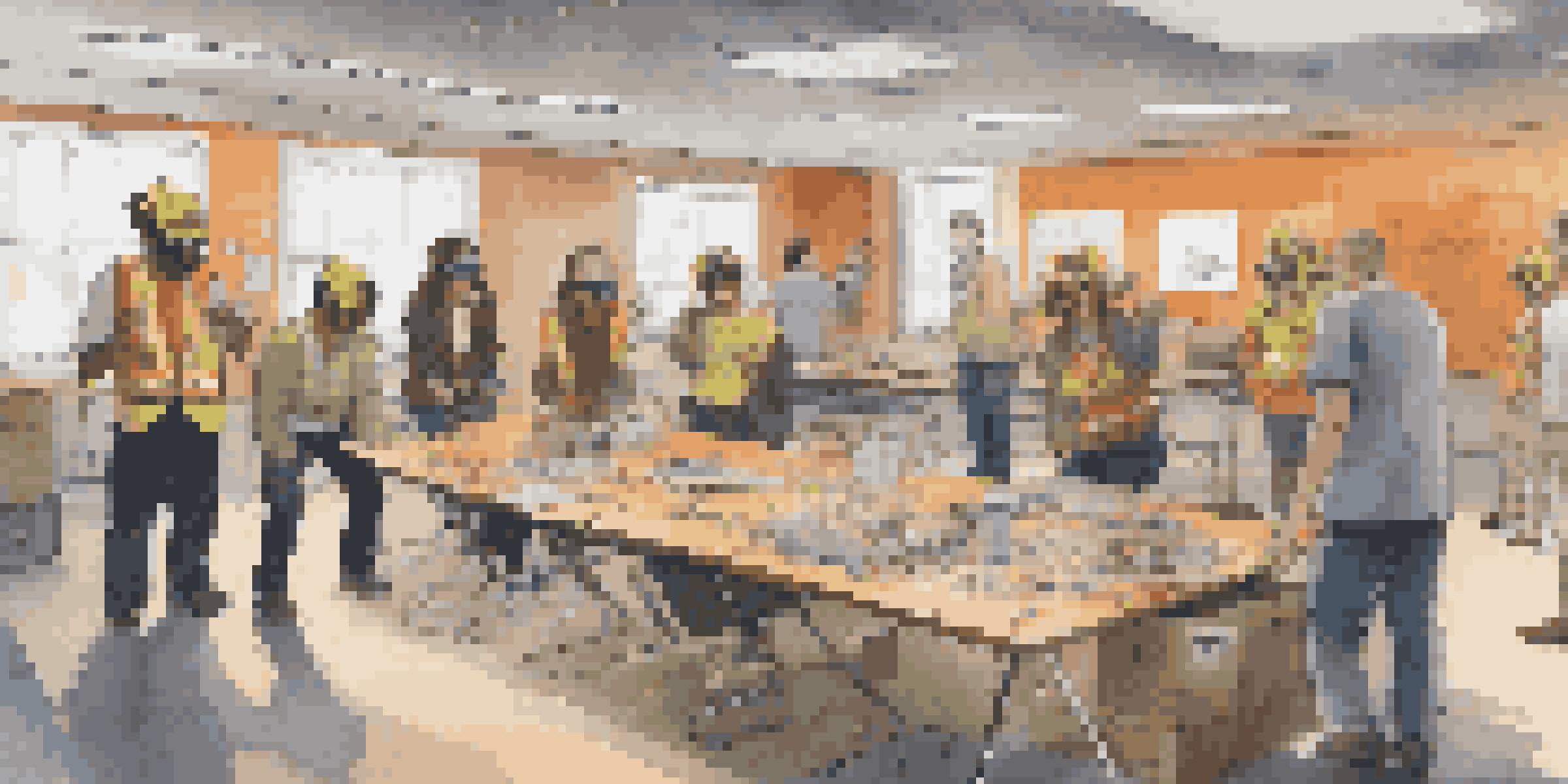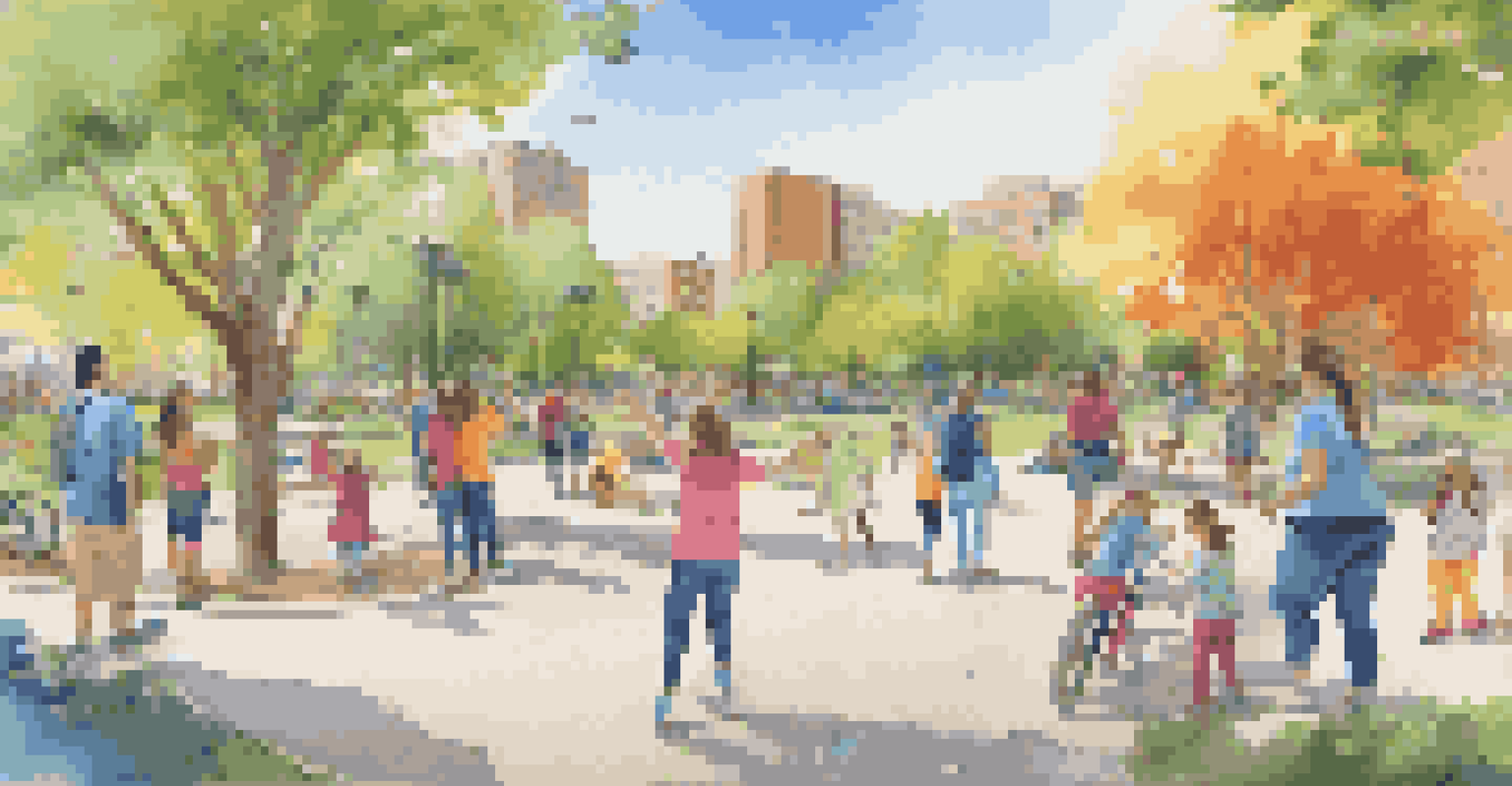Augmented Reality for Disaster Preparedness: Informing Citizens

Understanding Augmented Reality in Emergency Situations
Augmented Reality (AR) is a technology that overlays digital information onto the real world, allowing users to interact with both seamlessly. In the context of disaster preparedness, AR can provide crucial information in real-time, helping citizens navigate through emergencies. Imagine a device displaying evacuation routes overlaid on your actual surroundings—this is the potential of AR.
Technology is best when it brings people together.
This technology can guide individuals through critical situations, such as floods or earthquakes, by visually enhancing their environment. For instance, during a wildfire, AR can highlight safe zones and danger areas, making it easier for people to understand their options. By merging digital content with reality, AR transforms how we perceive and react to emergencies.
Incorporating AR into disaster preparedness not only makes information more accessible but also more engaging. Visual cues can significantly improve retention and understanding, especially in high-stress scenarios where clarity is paramount. As we explore its applications further, the impact of AR becomes increasingly evident.
Enhancing Situational Awareness with AR Applications
One of the most significant benefits of AR in disaster preparedness is its ability to enhance situational awareness. AR applications can provide users with live data, such as weather updates, hazard alerts, and even nearby resources like shelters. This real-time information helps individuals make informed decisions quickly, which is essential during a crisis.

For example, during a hurricane, an AR app could show wind speeds, flood zones, and even the locations of emergency services. This level of detail allows people to visualize the risks around them, fostering a better understanding of their environment. When citizens are informed, they can act more decisively and reduce panic.
AR Enhances Emergency Navigation
Augmented Reality provides real-time overlays of critical information, such as evacuation routes, helping citizens navigate during emergencies.
Furthermore, AR can cater to various audiences, including those with disabilities. By providing auditory cues or sign language overlays, these applications can ensure that everyone receives critical information. In this way, AR not only enhances awareness but also promotes inclusivity.
Training and Simulation: Preparing Citizens with AR
AR is not just about real-time information; it's also a powerful tool for training and simulation. Emergency services can use AR to create realistic scenarios for training purposes, allowing citizens to practice their responses in a safe environment. This hands-on experience can be invaluable when a real disaster strikes.
In the face of disaster, being prepared is the key to survival.
Imagine a community workshop where residents use AR glasses to simulate navigating through a simulated earthquake aftermath. They could practice finding exits, identifying safe spots, and understanding basic first aid—all while receiving guidance through the AR interface. This immersive learning experience can help build confidence and preparedness.
Moreover, these training sessions can be tailored to specific community needs, ensuring everyone is equipped with the knowledge they need. By integrating AR into training programs, we can cultivate a culture of preparedness that empowers citizens to handle emergencies effectively.
Community Engagement: Building Trust Through AR Initiatives
Community engagement is vital in disaster preparedness, and AR can play a significant role in fostering this connection. Local governments and organizations can use AR campaigns to educate citizens about emergency procedures and resources available to them. By making information interactive and visually engaging, communities can enhance participation and commitment.
For example, an AR app might host a virtual scavenger hunt where participants locate emergency supplies or learn about evacuation routes. This interactive experience not only makes learning fun but also creates a shared sense of responsibility among community members. When people feel involved, they are more likely to take preparedness seriously.
Training with AR Boosts Preparedness
Using AR for training allows citizens to practice emergency responses in simulated environments, building confidence and readiness for real disasters.
Additionally, AR initiatives can help bridge the gap between authorities and citizens. By providing a platform for two-way communication, communities can share feedback and concerns, leading to more effective disaster response strategies. Trust is built through transparency and engagement, and AR can be a key facilitator in this process.
Challenges in Implementing AR for Disaster Preparedness
While the potential of AR in disaster preparedness is exciting, there are challenges to consider. One major concern is the accessibility of technology. Not everyone has access to smartphones or AR-enabled devices, which could create a divide in information dissemination. Ensuring that AR solutions are available to all citizens is crucial for their effectiveness.
Moreover, the reliability of AR applications during disasters is another important factor. In high-pressure situations, technology can fail or become compromised. It's essential for developers to create robust systems that can function even in adverse conditions, ensuring that users can rely on them when it matters most.
Lastly, data privacy and security must be prioritized. As AR applications collect and utilize personal data, clear guidelines and protections are necessary to safeguard user information. Addressing these challenges is vital to realizing the full potential of AR in disaster preparedness.
Real-World Examples of AR in Disaster Preparedness
Several cities around the world are already exploring the use of AR for disaster preparedness. For instance, in Japan, AR technology is employed to visualize seismic activity and provide citizens with real-time alerts about earthquakes. This innovative approach has significantly heightened awareness and preparedness in a country frequently affected by natural disasters.
Another notable example is the use of AR in the United States during hurricane season. Local authorities have developed apps that allow residents to view potential flood zones and evacuation routes overlaid on their neighborhoods. This proactive measure helps residents plan ahead and stay informed during critical times.
Community Engagement Through AR
AR initiatives can foster community involvement in disaster preparedness, making learning interactive and building trust between citizens and authorities.
These real-world examples demonstrate the effectiveness of AR in real-life situations. By learning from these implementations, other communities can adopt similar strategies, tailoring them to their unique needs and challenges. The continued evolution of AR technology promises even more opportunities for enhancing disaster preparedness.
The Future of AR in Disaster Preparedness
Looking ahead, the future of AR in disaster preparedness is bright and full of possibilities. As technology advances, we can expect more sophisticated AR systems that integrate artificial intelligence and machine learning. These innovations could provide even more accurate predictions and tailored advice to citizens during emergencies.
Imagine an AR application that not only displays real-time data but also learns from user interactions to offer personalized recommendations. This could revolutionize how we prepare for and respond to disasters, making each citizen's experience unique and effective. The potential for growth in this field is enormous.

However, for AR to reach its full potential, collaboration among tech developers, emergency services, and communities is essential. By working together, we can create comprehensive solutions that empower citizens and enhance disaster resilience. The journey toward a more prepared future is just beginning, and AR will undoubtedly be a key player.